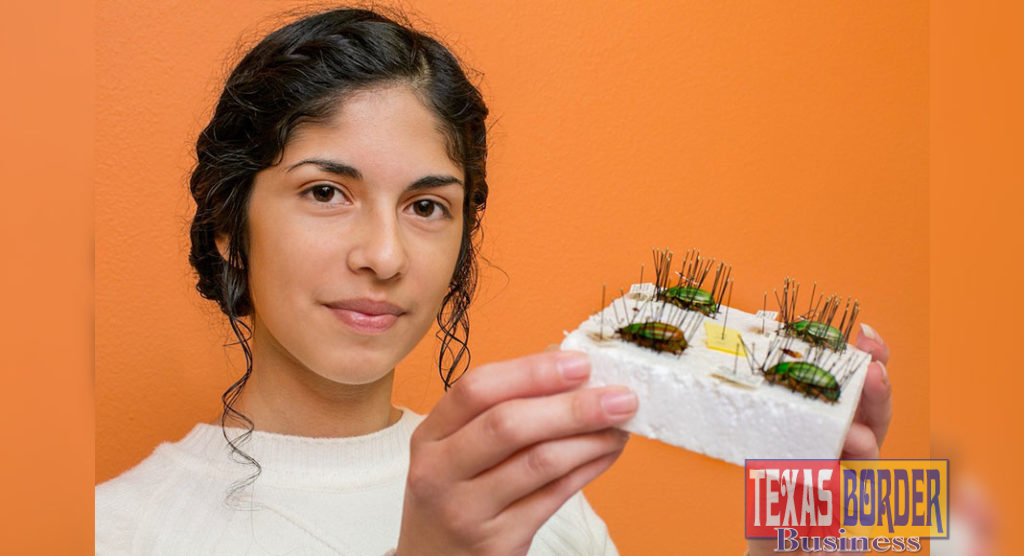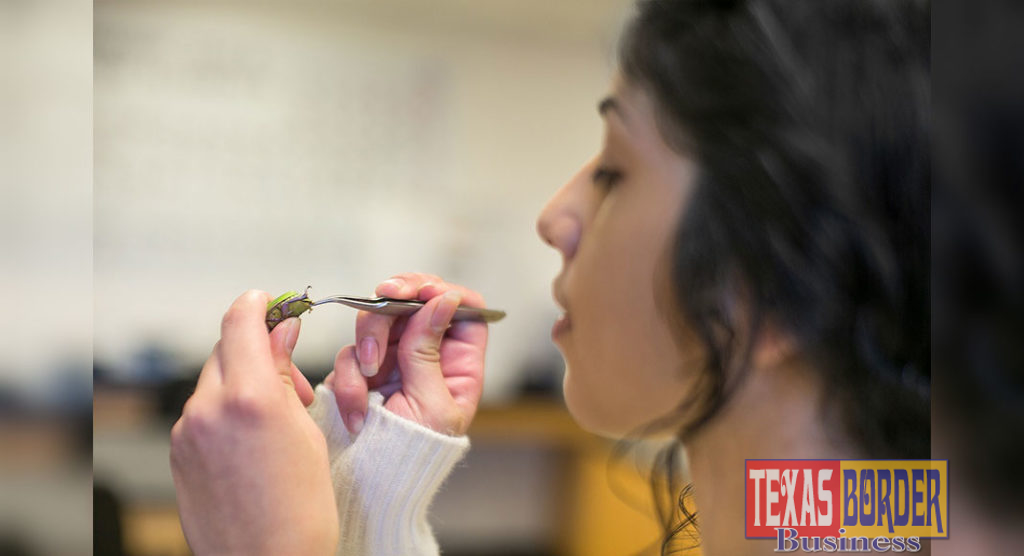
Texas Border Business
McAllen, Texas – Armed with a high-powered microscope, South Texas College dual student Brianna Miranda prepares a delicate routine as she readies a number of colorful beetles for her research.
At first, observing her specimens intently, she then soaks them in water, dries them, and then carefully extracts the female plates and male capsules of the Mexican Chrysina
It might be off-putting for some, working with creatures that skitter or flit, but Miranda says the prospect of finding a never-before-seen species of the beetle is exciting. Her research with the insect has enabled her to branch out to the study of speciation as she completes a degree in Biology while still in high school.
More importantly, her work with the beetle will have a profound impact on her future and bring a vital research component typically not seen at STC, she says.
Biology faculty and dual credit students conducting research reflects the college’s core values and emphasizes Dual Credit Programs mission to be a selective and competitive program committed to students at different levels.
“The fact that you can take these findings and apply them to larger principles and larger problems, I find that fascinating,” Miranda said. “I find the trial and error aspect of research very interesting. You may not find something, but if you do, that one possibility could make a difference. You could find a new species.”
As a student with Dual Enrollment Medical Science Academy (DEMSA) at South Texas College, Brianna is now in her second year assisting faculty at STC’s Mid Valley Campus by researching factors that keep the beetles from breeding, which then prompts them to form new species. “You could discover something that maybe could lead to further findings. I find that very interesting as well,” Brianna said.
Brianna calls the process highly fascinating and descriptive of an early passion for research.
“I’m very glad that South Texas College promotes this through the Dual Academies and through these different initiatives that I participated in through my time here,” she said. “I think their promotion of science is really monumental and I hope that it will continue to grow and expand. I feel like I have learned a lot through this project.”
Currently a high school senior and Biology major, Brianna said she initially learned about the unique project through DEMSA and was introduced to Dr. David Robacker who was working on speciation of the beetle.
DEMSA is one of five academy programs that comprise STC’s Dual Enrollment Academy enabling high achieving students to earn an Associate of Science in Biology, an Associate of Science in Computer Science, Associate of Science in Engineering, Associate of Arts in Business Administration, and an Associate of Arts in Criminal Justice.
Since the Dual Enrollment Academy Programs inception in 2005, over 1,000 high school seniors graduated with an Associate degree in their field of study. Moreover, over $20 million of scholarships have been offered, by universities and foundations, for Academy Program graduates to continue their education.
In Brianna’s case, the study of the insects further prepares her for a likely major in Biochemistry, Biology or Biomedical Science. She is currently one of four students in the academy currently assisting Dr. Robacker with the beetle research.

A noted expert in the study of the Chrysina genus, Dr. Robacker has been working with the beetle for over 20 years and has collected over 100 different species from around the world. He has also discovered at least two species which no one else had seen before and had one of those, Chrysina robackeri, named after him.
Robacker says work on Chrysina adelaida in academia is limited to only a few researchers across the country including David Hawks, who is unofficially affiliated with the University of California in Riverside and Michelle Zamarron, soon to be a student at Oregon State University working on her Ph.D. in molecular genetics in the agronomy department.
This feature puts STC at the forefront for research into the insect as scientists have been studying the movements of the insects as indicators of climate change, Robacker said.
“As far as I know, nobody else is working on Chrysina adelaida, other than those mentioned,” Dr. Robacker said. “Research into the systematics of the genus Chrysina, however, is a very active around the world, even though the geographical distribution of Chrysina is restricted to the new world from the southwest US to Ecuador.
“Approximately two papers per year are published describing new species in the genus,” Dr. Robacker said. “Currently, there are about 120 species in the genus and I am actively working on descriptions of two to three new species from what is currently known as Chrysina resplendens.”
The ruteline scarab beetle Chrysina along with genera like Plusiotis and Pelidnotopsis are sometimes referred to as “jewel scarabs” for their brilliant iridescent and metallic colors including green, pink, purple, blue, silver, and gold. They belong to a group of about 150 species found mostly in México and Central America.
Coming full circle, Dr. Robacker says he now looks forward to eventually naming Brianna as an author for her work with the insect. Robacker says having students enter research about the insects and eventually having their work published will significantly boost their career prospects.
“Eventually when we get done with this work, and it could be several years, she (Brianna) may be off to Harvard by then, but I will write it up and if it gets accepted into a taxonomy journal then it will be a new species,” Robacker said. “So once it’s peer-reviewed by other scientists and they accept it, then it becomes official.
“If she sticks with it long enough and does a substantial amount of work then I will name her as an author on the research,” he said.
Briana says she feels she is part of a unique and important phenomenon as she continues her work with the insect. Peering through her microscope, she explains how STC has given her the tools to pursue her degree within Biology.
“The professors here at South Texas College have been very encouraging, and helpful,” Miranda said. “I can definitely see myself majoring in something like biochemistry, biology, or biomedical science. That is what I am applying to since I’m in the process of applying to college. That will be the next step for me.
“I’m very glad that South Texas College promotes that through the Dual Academies and through these different initiatives that I participated in through my time here,” she said.












